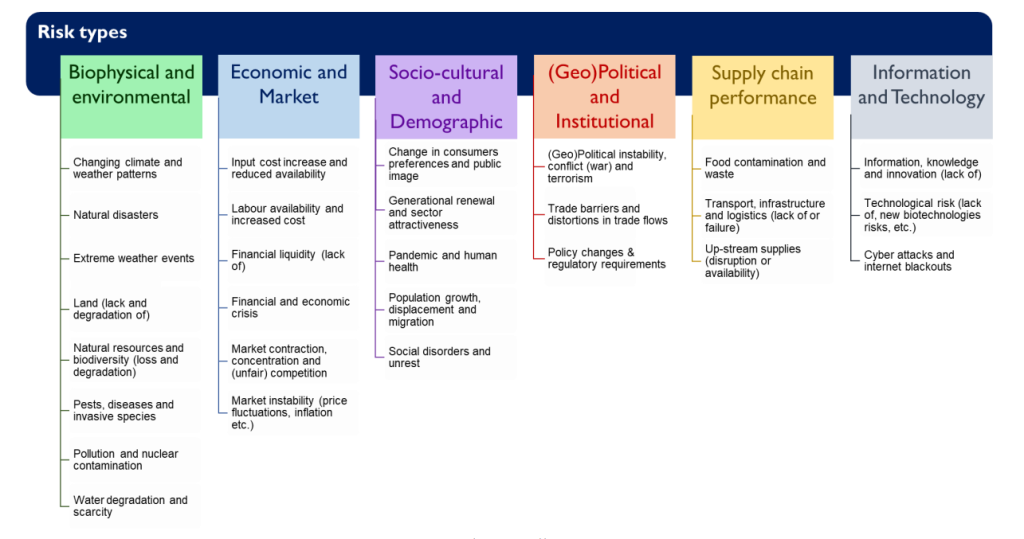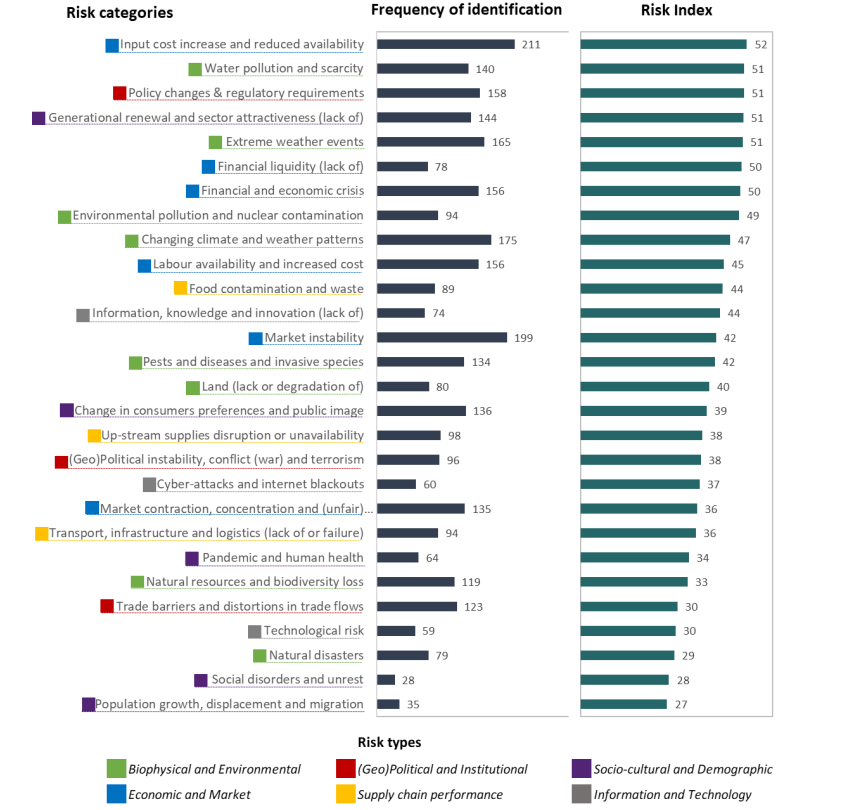Introduction
In response to the growing uncertainties and challenges affecting EU food systems, the European Commission adopted the Contingency Plan for maintaining food supply and security in times of crisis. This article summarizes the European Commission study “Risks and vulnerabilities in the EU food supply chain”, which provides a thorough picture of the range of perceived hazards in the food supply chain.
Objectives of the study on risks and vulnerabilities
- Identification of potential risks to the EU food supply
- Assessment of the vulnerability of the EU food supply chain
- Identification of the key risks for the EU food supply chain
Structure of the study
The study’s approach focused on qualitative and quantitative analytical methodologies, with data gathered via a systematic literature review, and information gathered directly from stakeholders of the food industry via semi-structured interviews and an online survey. The authors further processed the data to extrapolate meaningful information following these steps:
- Literature and interviews provided data to define 6 risk types and 28 categories. (Fig.2)
- A frequency analysis provides information about the origin time horizon of occurrence and relative importance for all risk categories and their sub-groups.
- A numeral scale provides information about the potential impact, the likelihood of occurrence, and the degree of vulnerability for all risk category sub-groups.
- Risk exposure and degree of vulnerability together generated an overall Risk Index for each risk category.
Factors of vulnerability
The vulnerability of a food supply chain describes its inability to respond to the negative consequences of hazards. As a result, vulnerability is conditional on the occurrence of a certain risky event. The authors of the study “Risks and vulnerabilities in the EU food supply chain”, identified 9 main factors of vulnerability. (Fig. 1)

Description of the risk types
- Biophysical and Environmental risk types have significant and immediate effects on the production of food and include all risks that result from the natural surroundings in which food systems function. Moreover, risks associated with this category are expected to increase in the following years. Read this article to learn more about how disasters can affect food security.
- Economic and Market risk types describe risks associated with market disturbances as well as unfavorable economic and financial conditions endangering food systems.
- Socio-cultural and Demographic risk is the result of shifts in the stability of society and its demographic makeup. In fact, the supply chain may need to react quickly to changes in sociocultural behavior, which isn’t always feasible or economical. This article offers more insight into how consumer trends challenge food safety.
- (Geo)Political and Institutional risks are the results of the modifications to the current trade agreements or policy framework, as well as (geo)political instability.
- Supply chain performance risk types arise from problems impacting food management, logistics, operations, and input provision in the food supply chain.
- Information and Technology risk types describe risks stemming from a lack of knowledge, or technological disruptions.

Summary of the results of the analysis by category type
Overall, the researchers found that the biophysical and environmental, economic market and socio-cultural and demographic risk types are the most commonly identified ones across all sources and are also the risks that have received more attention from scientists and policymakers over the last ten years.
Additionally, the interviews capture the opinions of stakeholders about the variety of risks that could impact the industry in the present and the future. The interviews most frequently identify (geo)political and institutional, biophysical and environmental, and finally economic and market risks as the risk types stakeholders are most concerned about.
Concerning perceived exposure values, it is interesting to note how less frequently identified categories received a very high exposure score, and therefore are perceived as highly hazardous by stakeholders. Namely, the categories with the highest exposure values are lack of financial liquidity, extreme weather events, Input cost increase or reduced availability, policy change and regulatory requirements, lack of generational renewal, water degradation and scarcity, food contamination, and waste, and environmental pollution and nuclear contamination.”
The authors also asked the stakeholders to assign an origin (domestic, EU, or extra EU) and a temporal horizon to each risk category sub-group. Overall, the results show the effects of globalization and recent events such as COVID-19 and Russia’s invasion of Ukraine have an impact on the responses.
To read the results of the analysis more in detail, check the full article here.
Key risks to food supply and security
Based on the results from the analysis, each risk category receives a Risk Index value. The categories with a high-risk Index value were deemed to require significant attention.
The findings of the analysis show that the most dangerous risk types to the EU food supply chain are biophysical and environmental risks, along with economic and market risks. Fortunately, stakeholders do not fail to identify the risk categories with higher Risk Index. However, environmental pollution, nuclear contamination, and lack of financial liquidity are some categories that show a high-Risk Index but do not get frequent recognition.

Heterogeneity of risks across the EU food supply chain
Despite belonging to the same geographical area, the European continent harbors many different countries that face different challenges. Moreover, some areas are more vulnerable than others. This is true for the EU’s most remote areas: the inaccessibility of markets, transportation networks, trade, and resources resulting from these remote and insular regions can pose challenges to the growth and continuity of food production. Overall:
- Except for “information and technology risks”, which vary the most among Member States, all risk categories have a similar Risk Index.
- The Member States with the highest Risk Index are Malta, Hungary, Spain, Romania, Czechia, Croatia, Portugal, Bulgaria, and Poland.
- The Member States with the lowest Risk Index are Slovakia, Luxembourg, Estonia, Germany, Lithuania, France, Slovenia, and the Netherlands.
Risks by sector and stage of the supply chain
Overall, there are risk categories that seem to affect all sectors, namely environmental pollution, severe weather, crises in the economy and finances, generational renewal, and knowledge deficiency.
According to an analysis of the Risk Index, the industry most affected is, on average, the fishery and aquaculture sector, followed by the beverage and alcoholic drinks sector. On the counterpart, dairy is the industry with the lowest average Risk Index. Lastly, other sectors have equal Risk-Index.
Different risk categories affect different stages of production in the food chain. For example, market volatility, risks associated with changing policy, and food contamination are the primary factors affecting input suppliers at the stage of the supply chain. Conversely, producers face numerous biophysical and environmental risks along with risks associated with low financial liquidity continuing to be significant. Risks connected to policy and regulatory changes primarily impact processors and packaging operators. Finally, environmental pollution and input costs, as well as evolving customer preferences, cyberattacks, and others, affect logistic operators and wholesalers in the same way.
Conclusion
The study “Risks and vulnerabilities in the EU food supply chain” serves as a reminder that the food supply chain is susceptible to a wide range of risks. Overall, the report shows that stakeholders do not fail to identify the risks to which the supply chain is most exposed overall: biophysical, environmental, and economic risks, as well as market risks. These risks are overall well studied and understood. But, along with well-understood risks, relatively new risks are surfacing and this should be kept in mind when looking for future solutions.
This study highlights the critical need to be ready to handle the unexpected, which is consistent with current events such as the COVID-19 pandemic and the war in Ukraine. Based on their specific characteristics, strategies should be developed to address the risks affecting the food supply chain. For example, whether measures that address the risk’s source would be more beneficial or not could be decided using the results of this study.
Source
European Commission. (2023). Risks and vulnerabilities in the EU food supply chain – Mapping and analysis based on a stakeholder survey. https://op.europa.eu/en/publication-detail/-/publication/a98107e4-88f3-11ee-99ba-01aa75ed71a1/language-en
Related articles to Risks in the EU food supply chain
Many customers and visitors to this page 'Risks in the EU food supply chain' also viewed the articles and manuals listed below:
